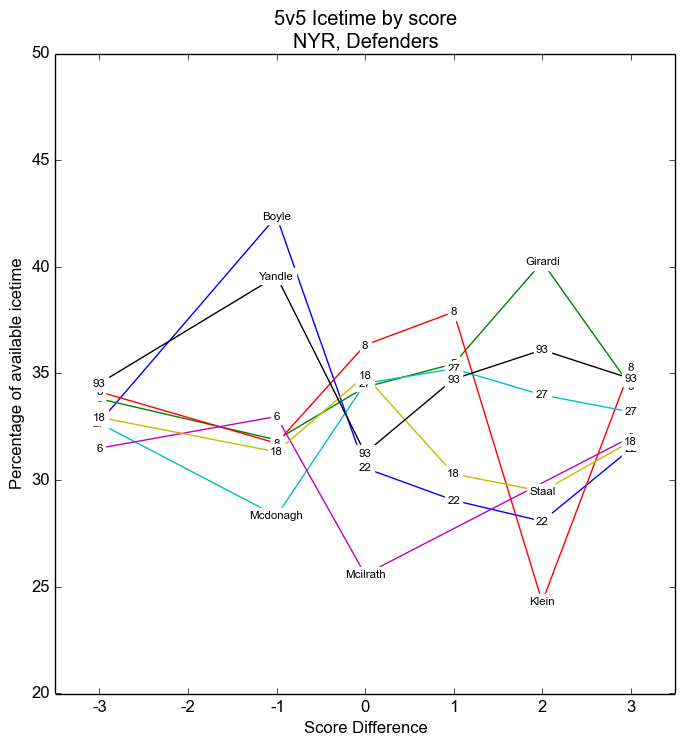
Yandle. Good at hockey.
Much of the focus of our frustrations this year has been on the defense. It’s been ranging from singling players out for poor play to overall team defense and poor execution. Part of this problem comes from deployment and a lack of willingness to move away from veterans that are struggling this season. That part lies with the coaching staff, particularly Ulf Samuelsson and Alain Vigneault.
When a team is protecting a lead, you expect the best defensive units to be on the ice. Likewise when the team is behind, you expect the best offensive players to be out on the ice. Luckily Micah McCurdy has put together a great site called hockeyviz.com, which takes the deployment and puts it into easy to understand visuals. First, let’s look at who AV puts out there in game situations.

Courtesy of hockeyviz.com
This chart is easy to understand. Each player has his own line, and the deployment is based on the score differential on the horizontal axis. The vertical axis is ice time based on the score situation. So for example, Dan Boyle and Keith Yandle get the most time on the ice when the Rangers are down one goal (score difference of -1). Interestingly enough, Ryan McDonagh gets the least amount of ice time, less than Dylan McIlrath. When the Rangers are protecting a one goal lead, Kevin Klein gets the most ice time, and then it’s about even for McDOnagh, Yandle, and Dan Girardi.
Perhaps the one thing I find to be very interesting is the overall deployment of Marc Staal. Staal isn’t relied upon for offense, as expected. But Staal’s ice time also drops significantly when protecting a lead. It appears that most of Staal’s minutes are during a tie game or during some kind of garbage time.
The next aspect to look at is effectiveness of the specific pairings used by AV. This has also been a major topic of discussion, mostly because the pairing of Staal/Girardi has been miserable. Hockeyviz gives us an easy visual to analyze this as well.

Courtesy of hockeyviz.com
To explain this chart:
- The top right side has each player and the number of minutes received thus far.
- The bottom right side has each pairing and the number of minutes played by that specific pairing.
- The left side has the overall flow of play when a specific player/pairing is on the ice. Each corner has a type of flow. Lower right is “fun”, lower left is “bad”, etc. So a player that is in the lower right corner means there are a lot of shot attempts taken by both teams when he is on the ice. The upper right means a lot shot attempts for his team, but few against.
- Just a warning for Girardi defenders: This does not make Girardi look good at all.
So when we look at this, the first thing noticeable is the 18+5 pairing (Girardi/Staal) in the bottom left corner. Simply put, that is a bad combination. Lots of shot attempts against, few for, so they are getting pinned in their own zone a lot. The next thing to notice is right above where 27+5 and 5 are, still in the “bad” category. There is only one pairing with Girardi that looks good, and that is when he is with Yandle. The effect Girardi has on his defense partner is just awful. I don’t know how else to put it. If it’s any consolation for Girardi, Staal isn’t exactly looking to good either.
To really hammer this home, look at how much better McDoangh is when he plays with Klein. That pair is over the median line and towards the “good” part of things. They suppress shots against, and do a good job generating shot attempts for. And the only thing that changed there is the defense partner.
One last item to look at is the effect Yandle has on his teammates. He drags Girardi out of the gutter, he makes McIlrath look like a stud, and him and Klein make arguably the best Rangers defense pairing. Yandle is a very good defenseman and is very good at hockey.
This brings us back to deployment. Girardi and Staal are not having good years. Anyone watching the Rangers this season can tell you that. But yet, they are still top-two in ice time–remember that Girardi’s missed some time– for the Rangers. Their two worst defenders get the most amount of ice time. Meanwhile, one kid that has looked solid all year (McIlrath) still doesn’t get much ice time in critical situations. This isn’t to say McIlrath is better, it’s just saying he’s certainly deserving of some more ice time to see what he can do, especially with Staal and Girardi’s struggles.
Something has to give with this deployment at some point. Ice time for those playing poorly needs to be taken away. It’s called accountability. Why does accountability only apply to rookies, and not to veterans? That’s only for Alain Vigneault to answer.
Share:
More About:Defense
